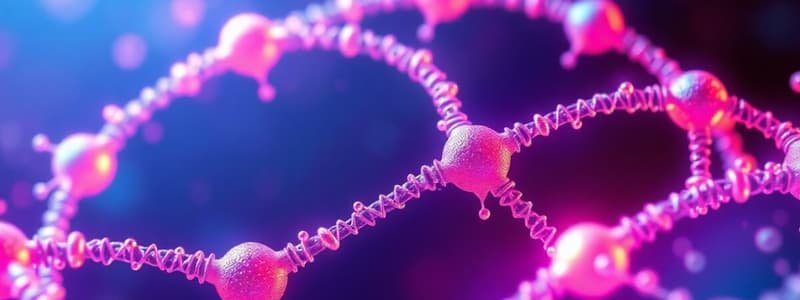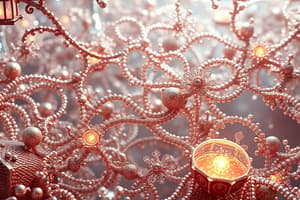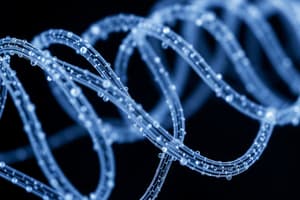Podcast
Questions and Answers
What constitutes the core of a nanowire?
What constitutes the core of a nanowire?
- A functionalized layer
- A primary material (correct)
- A coating material
- A secondary material
Which of the following materials is NOT typically found in the structure of nanowires?
Which of the following materials is NOT typically found in the structure of nanowires?
- Copper
- Glass (correct)
- Germanium
- Silicon dioxide
What describes the function of the shell in a nanowire structure?
What describes the function of the shell in a nanowire structure?
- It serves as a substrate for other materials.
- It is made of a secondary material. (correct)
- It controls the overall length of the wire.
- It acts as the innermost layer.
Which synthesis method is NOT typically used for creating nanowires?
Which synthesis method is NOT typically used for creating nanowires?
What is the primary benefit of using E-beam lithography (EBL) in nanotechnology?
What is the primary benefit of using E-beam lithography (EBL) in nanotechnology?
Which type of nanowire has a unique structure that separates a core and a shell?
Which type of nanowire has a unique structure that separates a core and a shell?
Which feature makes E-beam lithography advantageous for microelectronics?
Which feature makes E-beam lithography advantageous for microelectronics?
What determines the properties and applications of nanowires?
What determines the properties and applications of nanowires?
Study Notes
Nanowire Structure
- Nanowires have a core, shell, and surface
- The core is the primary material of the nanowire
- Some nanowires have a shell which is a secondary material
- The surface can be functionalized
- Nanowires can have interfaces with other materials
Nanowire Materials
- Nanowires can be made from various materials
- Metals like gold, silver, and copper
- Semiconductors like silicon and germanium
- Insulators like silicon dioxide and alumina
- Conducting polymers such as PEDOT and PANI
Nanowire Shapes and Morphologies
- Nanowires can have various shapes and morphologies
- Straight, bent, curved, branched, core-shell, and hollow nanowires
Nanowire Synthesis Methods
- Nanowire structure can be controlled through synthesis methods
- Vapor-liquid-solid (VLS) growth
- Solution-liquid-solid (SLS) growth
- Chemical vapor deposition (CVD)
- Molecular beam epitaxy (MBE)
- Electrochemical deposition
Nanowire Properties and Applications
- Nanowire structure affects their properties and applications
Electron-Beam Lithography (EBL)
- A technique to create high-resolution patterns on substrates
- Uses a focuses beam of electrons to expose a resist material
Key Aspects of EBL
- Utilizes a focused electron beam
- Uses a resist material that changes its chemical composition when exposed to the electron beam
- Creates patterns in the resist material by scanning the electron beam across the substrate
- Can achieve resolutions of 10 nm or smaller
- Does not require a mask - the pattern is created directly on the substrate
EBL Applications
- Fabrication of integrated circuits, transistors, etc
- Creation of nanostructures like:
- Nanowires
- Nanotubes
- Nanoparticles
Studying That Suits You
Use AI to generate personalized quizzes and flashcards to suit your learning preferences.
Related Documents
Description
This quiz covers the fundamentals of nanowires including their structure, materials used, various shapes, and synthesis methods. Learn about the unique properties of nanowires and their applications in modern technology. Test your knowledge on core-shell configurations and growth techniques like chemical vapor deposition.




